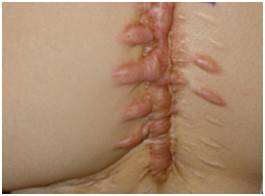Scars
Scars result when the skin repairs wounds caused by accident, diseases, or surgery. They are a natural part of the healing process.
Typically, a scar may appear red and thick at first, and then gradually fade. Many actively healing scars that seem unsightly may heal nicely if given more time.
The way a scar forms is affected by an individual's age and the location on the body or face. Younger skin makes strong repairs and tends to over heal resulting in larger, thicker scars. A scar that crosses natural expression lines or is wider than a wrinkle will be more apparent because it will not follow a natural pattern, nor look like a naturally occurring line.
Treatment
Several techniques can minimize a scar. Most of these are done routinely in the dermatologist's office. However, no scar can ever be completely erased, and no technique will return the scar to its normal uninjured appearance.
Resurfacing
Resurfacing is a method of treating acne scars, some surgical scars, or minor irregularities of the skin surface. A laser is use to remove the top layers of skin to give a more even contour to the surface of the skin. While it can offer improvement for certain scars, it cannot get rid of the scar entirely. Several sessions may be required if defects are deep and extensive, as in deep acne scars.
Pulsed dye laser
A pulsed dye laser uses yellow light to remove scar redness and to flatten raised scars (hypertrophic scars or keloids). This laser can also improve itching and burning sensations in the scar.
Soft tissue fillers
Various injectable substances are available to elevate indented scars. The amount of material injected will vary with the size and firmness of the scar. Improvement is immediate but is not permanent and often need to be repeated. The dermatologist will discuss the available "fillers" and help you decide which is best for your scar.
Cortisone (steroid) injection
These can soften very firm scars (or keloids) causing them to shrink and flatten. This treatment is popular (along with pulsed dye laser) for hypertrophic scars and keloids.
Adapted from the American Academy of Dermatology
The information above is a partial and general information and cannot replace the needed specific medical examination and consultation

